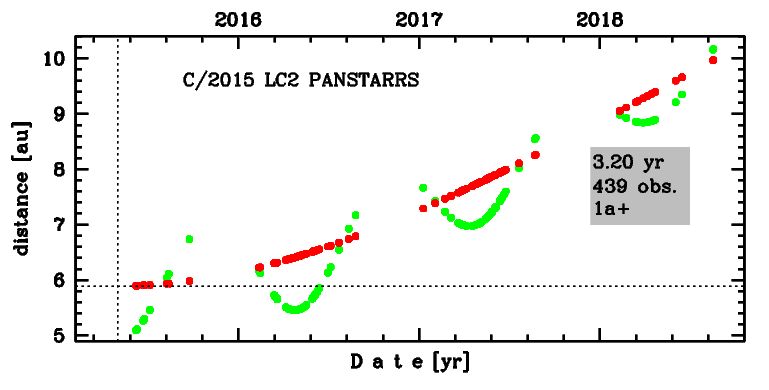C/2015 LC2 PANSTARRS
more info
Comet C/2015 LC2 was discovered on 7 June 2015 with Pan-STARRS 1 telescope (Haleakala), that is about a month
after its perihelion passage.This comet was observed until 17 August 2018.
Comet had its closest approach to the Earth on 8 May 2015 (4.939 au), a week after its perihelion passage.
Solution given here is based on data spanning over 2.78 yr in a range of heliocentric distances from 5.90 au to 9.97 au.
This comet suffers insignificant planetary perturbations during its passage through the planetary system; have original semimajor axis shorter than 10000 au.
Comet had its closest approach to the Earth on 8 May 2015 (4.939 au), a week after its perihelion passage.
Solution given here is based on data spanning over 2.78 yr in a range of heliocentric distances from 5.90 au to 9.97 au.
This comet suffers insignificant planetary perturbations during its passage through the planetary system; have original semimajor axis shorter than 10000 au.
| solution description | ||
|---|---|---|
| number of observations | 439 | |
| data interval | 2015 06 07 – 2018 08 17 | |
| data type | observed only after perihelion (POST) | |
| data arc selection | entire data set (STD) | |
| range of heliocentric distances | 5.9 au – 9.97au | |
| detectability of NG effects in the comet's motion | NG effects not determinable | |
| type of model of motion | GR - gravitational orbit | |
| data weighting | YES | |
| number of residuals | 876 | |
| RMS [arcseconds] | 0.45 | |
| orbit quality class | 1a+ | |
| next orbit statistics, both Galactic and stellar perturbations were taken into account | ||
|---|---|---|
| no. of returning VCs in the swarm | 5001 | * |
| no. of escaping VCs in the swarm | 0 | |
| no. of hyperbolas among escaping VCs in the swarm | 0 | |
| next reciprocal semi-major axis [10-6 au-1] | 270.21 – 271.34 – 272.45 | |
| next perihelion distance [au] | 5.88128 – 5.88135 – 5.88142 | |
| next aphelion distance [103 au] | 7.335 – 7.365 – 7.396 | |
| time interval to next perihelion [Myr] | 0.2219 – 0.2233 – 0.2247 | |
| percentage of VCs with qnext < 10 | 100 | |
| next_g orbit statistics, here only the Galactic tide has been included | ||
|---|---|---|
| no. of returning VCs in the swarm | 5001 | * |
| no. of escaping VCs in the swarm | 0 | |
| no. of hyperbolas among escaping VCs in the swarm | 0 | |
| next reciprocal semi-major axis [10-6 au-1] | 270.20 – 271.33 – 272.44 | |
| next perihelion distance [au] | 5.87686 – 5.87694 – 5.87702 | |
| next aphelion distance [103 au] | 7.335 – 7.365 – 7.396 | |
| time interval to next perihelion [Myr] | 0.2219 – 0.2233 – 0.2247 | |
| percentage of VCs with qnext < 10 | 100 | |
